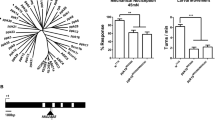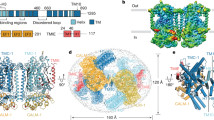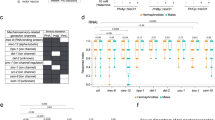Abstract
The elusive transduction channels for hearing are directly gated mechanically by the pull of gating springs. We found that the transient receptor potential (TRP) channel TRPN1 (NOMPC) is essential for this direct gating of Drosophila auditory transduction channels and that the channel-spring complex was disrupted if TRPN1 was lost. Our results identify TRPN1 as a mechanical constituent of the fly's auditory transduction complex that may act as the channel and/or gating spring.
This is a preview of subscription content, access via your institution
Access options
Subscribe to this journal
Receive 12 print issues and online access
$209.00 per year
only $17.42 per issue
Buy this article
- Purchase on Springer Link
- Instant access to full article PDF
Prices may be subject to local taxes which are calculated during checkout


Similar content being viewed by others
Change history
13 May 2013
In the version of this article initially published, grant acknowledgments for the Human Frontier Science Program (J.T.A.) and the Bernstein Centre Göttingen (M.C.G.) were missing. The error has been corrected in the HTML and PDF versions of the article.
References
Howard, J. & Hudspeth, A.J. Neuron 1, 189–199 (1988).
Tinevez, J.Y., Jülicher, F. & Martin, P. Biophys. J. 93, 4053–4067 (2007).
Albert, J.T., Nadrowski, B. & Göpfert, M.C. Curr. Biol. 17, 1000–1006 (2007).
Arnadóttir, J. & Chalfie, M. Annu. Rev. Biophys. 39, 111–137 (2010).
Kang, L. et al. Neuron 67, 381–391 (2010).
Howard, J. & Bechstedt, S. Curr. Biol. 14, R224–R226 (2004).
Sidi, S., Friedrich, R.W. & Nicolson, T. Science 301, 96–99 (2003).
Göpfert, M.C., Albert, J.T., Nadrowski, B. & Kamikouchi, A. Nat. Neurosci. 9, 999–1000 (2006).
Shin, J.B. et al. Proc. Natl. Acad. Sci. USA 102, 12572–12577 (2005).
Effertz, T., Wiek, R. & Göpfert, M.C. Curr. Biol. 21, 592–597 (2011).
Walker, R.G., Willingham, A.T. & Zuker, C.S. Science 287, 2229–2234 (2000).
Kamikouchi, A. et al. Nature 458, 165–171 (2009).
Yorozu, S. et al. Nature 458, 201–205 (2009).
Lee, J., Moon, S., Cha, Y. & Chung, Y.D. PLoS ONE 5, e11012 (2010).
Cheng, L.E. et al. Neuron 67, 373–380 (2010).
Nadrowski, B., Albert, J.T. & Göpfert, M.C. Curr. Biol. 18, 1365–1372 (2008).
Grubbs, F.E. Technometrics 11, 1–21 (1969).
Göpfert, M.C., Humphris, A.D., Albert, J.T., Robert, D. & Hendrich, O. Proc. Natl. Acad. Sci. USA 102, 325–330 (2005).
Burnham, K.P. & Anderson, D.R. Model Selection and Multimodel Interference: a Practical Information-Theoretic Approach, 2ndedn. (Springer, New York, 2002).
Acknowledgements
We thank R. Walker, L. Cheng, Y.-N. Jan, the Bloomington Stock Center, the Exelixis Collection at Harvard Medical School and the Nippon Consortium for fly strains. This work was supported by the Volkswagen Foundation (B.N.), the German National Academic Foundation (D.P.), Biotechnology and Biological Sciences Research Council (BB/G004455/1) and the Human Frontier Science Program (J.T.A.), and the Bernstein Centre Göttingen and German Science Foundation (DFG, SFB889-A1, M.C.G.).
Author information
Authors and Affiliations
Contributions
T.E. performed the experiments with the help of D.P. B.N. devised models and T.E. analyzed the data. J.T.A. devised methods and performed pilot studies. M.C.G. supervised the project and wrote the manuscript with T.E., B.N., D.P. and J.T.A.
Corresponding authors
Ethics declarations
Competing interests
The authors declare no competing financial interests.
Supplementary information
Supplementary Text and Figures
Supplementary Figure 1 and Supplementary Tables 1 and 2 (PDF 226 kb)
Rights and permissions
About this article
Cite this article
Effertz, T., Nadrowski, B., Piepenbrock, D. et al. Direct gating and mechanical integrity of Drosophila auditory transducers require TRPN1. Nat Neurosci 15, 1198–1200 (2012). https://doi.org/10.1038/nn.3175
Received:
Accepted:
Published:
Issue Date:
DOI: https://doi.org/10.1038/nn.3175
This article is cited by
-
Hearing of malaria mosquitoes is modulated by a beta-adrenergic-like octopamine receptor which serves as insecticide target
Nature Communications (2023)
-
Homeostatic maintenance and age-related functional decline in the Drosophila ear
Scientific Reports (2020)
-
RNA interference supports a role for Nanchung–Inactive in mechanotransduction by the cockroach, Periplaneta americana, tactile spine
Invertebrate Neuroscience (2020)
-
Fast intensity adaptation enhances the encoding of sound in Drosophila
Nature Communications (2018)
-
Sex and species specific hearing mechanisms in mosquito flagellar ears
Nature Communications (2018)



